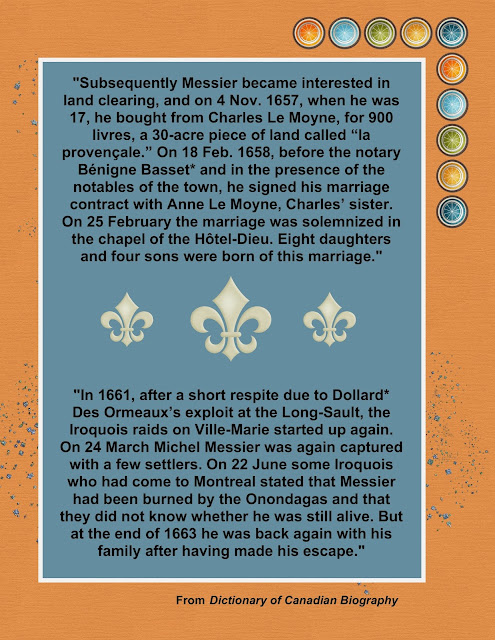Christian Frederich Kienlen, my 3rd great grandfather, had an interesting life - a true rags to riches story. He was born in
Marbach am Neckar, in the Kingdom of Wurttemberg, in 1799, the son of Johann Gottfried Kienlen and Marie Charlotta Schemp Kienlen. He was trained in the family business. He was a confectioner.
In 1815, in Indonesia, Mount Tambora erupted. This was, and still is, the largest volcanic eruption in recorded history. The world's climate changed suddenly, and the following year, 1816, is known as the "Year Without a Summer."
While Mary Shelly wrote Frankenstein and John Polidori wrote The Vampyre, people of lesser means were starving. Conditions in Wurttemberg were worse than in most places. People there resorted to eating moss, grass, and tree bark, and a mass exodus soon followed. Christian left his family and went to the United States as an indentured servant. That's a story for another day.
Christian eventually made his way to the boom-town of St. Louis. He was the first confectioner in the city, and his name is listed on many land deeds of that period. In 1837, however, he auctioned off his confectioners' tools and bought 100 acres of land in the wilderness of St. Louis County. It was here, in the area now know as Wellston, that Christian and Marie Louise Moreau Kienlen moved their young family.
According to family lore provided by my father, Richard L. Kienlen, Christian had a store on the St. Charles Road (now Martin Luther King Drive). He sold provisions to people going west. We still have the key to this store, which Christian's grandson George had nickel-plated.
Although I have found no evidence that this store existed, I have learned about his plantation.
According to my dad, the Kienlens built a large, 2-story brick home. There were even stone lions out front guarding the porch. At one time, there was a sketch of the house, but it disappeared when in the possession of my grandparents. Kienlen Avenue in the Wellston area of St. Louis County was the driveway through the property to their home.
In 1868, Marie Louise Kienlen sold 66 acres to Erastus Wells (for whom Wellston is named) for $17,000. The deal included the family home. Mr. Wells then built a three-story mansion on the property. His son Rolla Wells, one-time mayor of St. Louis, included this photo in his 1933 book Episodes of My Life:

Peeking from behind the left side of the house seems to be a brick, 2-story home. I can't prove this is the old Kienlen home, but it very well may be. Sadly, both homes burned down in later years.
This transcript from a 1965 KSD radio broadcast about Wellston mentions the Kienlen home:
"In 1868 Wells purchased a country home in the area which now
bears his name. Located a few blocks north of Easton Avenue, the spacious
house, with wide verandas extending across the first and second stories, had
been the farm home of the Kienlen family. The driveway which led to the house
is the present Kienlen avenue, on which stands the Wellston City Hall. The
handsome brick residence burned to the ground in 1893, after which the country
property, with its orchards, gardens, and vineyards, was subdivided into small
home sites."
Now we have conflicting evidence. Did Christian Kienlen built the house in the foreground above, or Erasatus Wells. It's really hard to know, but the orchards, gardens, and vineyards were probably started by the Kienlens. The home pictured seems to be of a later period than Kienlen would have built it, but I'm no architecture expert. The house behind the house is more likely.
So what do we know about the plantation? The Federal Agricultural Census of 1850 gives us some clues. This census lists what was produced in the year ending June 1, 1850, so it reflects the harvest of 1849. At that time, there were 50 improved acres and 50 unimproved acres. The cash value of the farm was $20,000, a lot of money in 1850. They had 4 horses, 4 milk cows, and 6 other cattle. They had 4 sheep and 20 pigs. They produced 200 lbs of butter.
They had grown 800 bushels of corn, 200 bushels of potatoes, and 95 tons of hay. They also grew 400 lbs of cotton and 1000 lbs of sugar cane. (The sugar cane surprised me.) They had $100 worth of produce from their orchard.
Christian lived at this site from 1837 until his death on December 31, 1851. His wife continued to live there until she sold it and moved in with her daughter Julia Kienlen Brokmeyer, wife of Missouri Lt. Governor (1877-1881) Henry Brokmeyer.
So what became of this land? Here's a little project I did a few years ago.
Interestingly, in 1905, construction workers building a house came upon the Kienlen family cemetery. I did not know this existed, and I now have another lead to follow. I assume they found and removed Christian. He and Marie Louise had children who died young, and those may be the other burials. The article is also proof that Rolla Wells is an imperfect source of information. He was incorrect in saying the Kienlens got their land from the Spanish government. In 1837 this was the state of Missouri, in the U.S.A.














